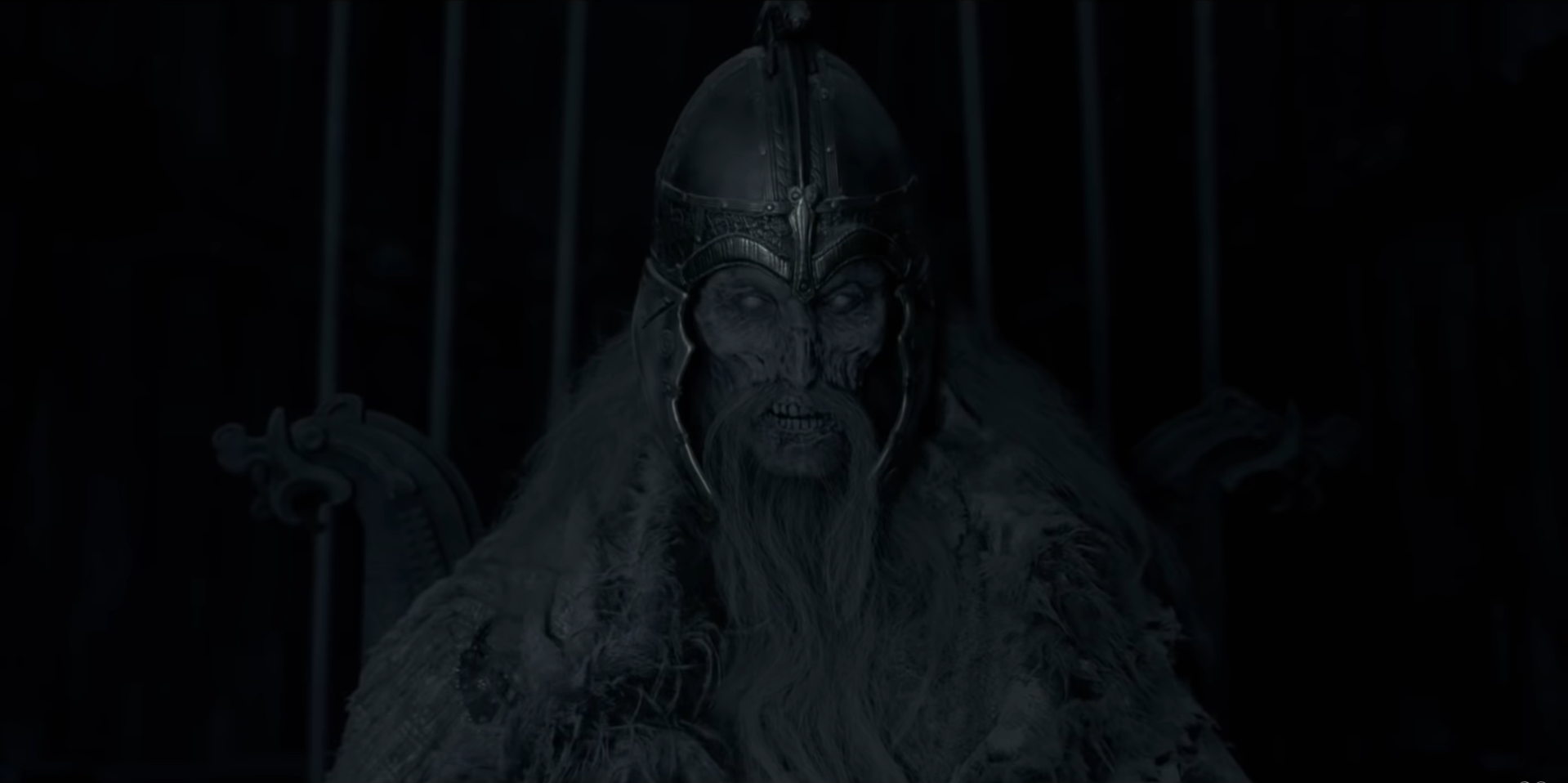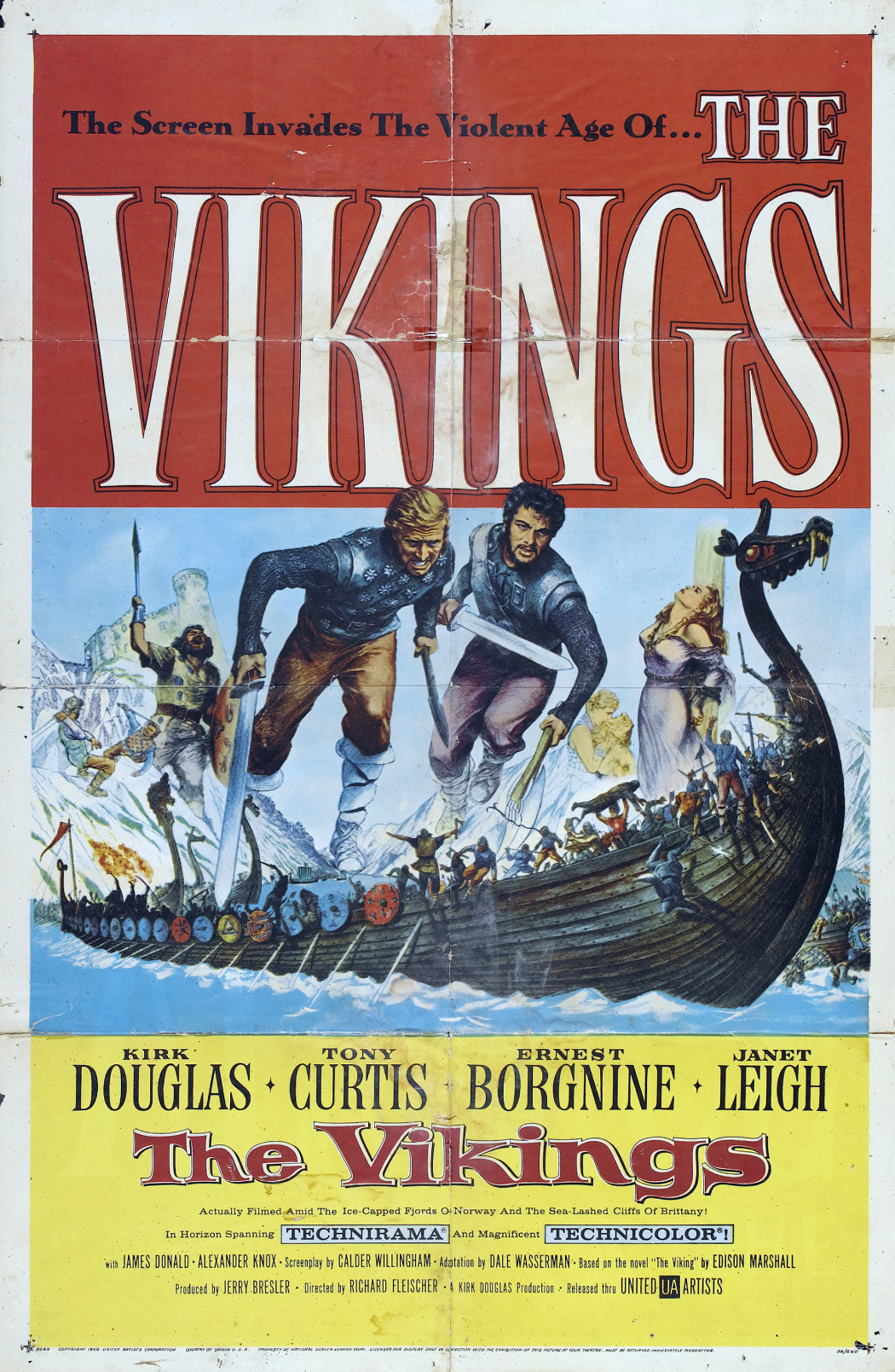At the 0:55 mark in the trailer we get three shots in two seconds. First, in a match cut from a deranged-looking Willem Dafoe, the corpse of a helmeted man enthroned in deep shadow. His eyes open. Next, presumably the same figure hunkering down behind a shield and raising a sword, a typical early medieval attack stance. Finally, an over-the-shoulder of the helmeted figure bearing down on the hero, Amleth (Alexander Skarsgård) as they fight in a tight, gloomy space surrounded by barrels, jars, and at least one shield, all within what looks like the gunwales of a ship.
It’s not much, but oh, how much it suggests. These two seconds show an instantly recognizable encounter with a mound-dweller—the ghost of Old Norse literature.
Caveats and corpses
I use the word ghost advisedly, since ghosts as the Norse conceived of and described them in the sagas are wildly different from the floating, translucent spooks you can simulate with a bedsheet. First, and most importantly, they are corporeal. These ghosts have bodies and can—and sometimes must—be killed a second time. In this respect they are more like zombies, undead revenants that can be killed. Unlike zombies, they are often swollen or grown to enormous size: “big as a bull” is a common description.
Second, it’s not typically hard to locate a mound-dweller. Just look for the mound or barrow where the undead was buried; this will usually be a local landmark. (Old Norse ghost-hunting shows would end after one episode, but probably be much more entertaining.) The mound-dweller, true to its name, could in a sense be said to “live” in its barrow.
Finally, mound-dwellers are almost always hostile. The bedsheet ghost or poltergeist might content itself with moaning at night or trashing a room. Mound-dwellers can be devastatingly destructive, killing cattle and any people it can catch.
Beyond that, there’s some variety in how these ghosts are described and how they behave, something reflected in the terminology. A commonly applied word is draugr, a general term for an undead revenant. I want to avoid implying that there’s a precise taxonomy to these creatures, but two other words for draugar are suggestive of different kinds:
After-walkers
The first, the aptrganga (literally the “after-walker,” i.e. walking around after he’s dead), roams around, usually at night, causing trouble and killing people or damaging property before returning to its barrow. These are the most fearful and destructive ghosts.
A famous is Víga-Hrappr or Killer Hrapp, a man who appears in Laxdæla saga or The Saga of the People of Laxardal. A pushy neighbor and household tyrant, Hrapp actually drives his neighbors to combine against him for mutual support. He finally dies—in bed, weakened but still malicious, and asking to be buried sitting upright so he can watch the house. These are all bad signs. The saga writer goes on:
But if it had been difficult to deal with him when he was alive, he was much worse dead, for he haunted the area relentlessly. It is said that in his haunting he killed most of his servants. To most of the people living in the vicinity he caused no end of difficulty and the farm at Hrappstadir became deserted.
One of the saga’s heroes, Hoskuld, disinters Hrapp and reburies him farther from everyone’s farms. “Hrapp’s haunting,” the saga writer tells us, “decreased considerably after this.” That’s not enough assurance for a lot of people, including Hrapp’s widow, who refuses to move back, so Hoskuld himself moves into the area. It’s Hoskuld’s son, Olaf the Peacock, who finally rids Laxardal of Killer Hrapp.
One evening the farmhand in charge of the non-milking cattle came to Olaf and asked him to assign the task to someone else and ‘give me other duties’.
Olaf answered, ‘I want you to look after your own duties.’
The man replied he would rather leave the farm.
‘Then you must think something is seriously wrong,’ Olaf said. ‘I’ll accompany you tonight when you tie the animals in their stalls, and if you’ve any cause for complaint, I won’t blame you. Otherwise you’ll pay for causing trouble.’
Olaf then took the spear known as the King’s Gift in his hand and went out, the servant following him. Quite a lot of snow had fallen.
They reached the cowshed, which stood open, and Olaf told the servant to go inside, saying. ‘I’ll herd the animals inside for you and you tie them in their places.’
The servant went towards the door of the cowshed but suddenly came running back into Olaf’s arms.
When Olaf asked what had frightened him so, the servant answered, ‘Hrapp is standing there in the doorway, reaching out for me, and I’ve had my fill of wrestling with him.’
Olaf approached the door and prodded with his spear in Hrapp’s direction. Hrapp gripped the spear just above the blade in both hands and gave it a wrench, breaking the shaft. Olaf made a run at him, but Hrapp let himself sink back down to where he had come from, putting an end to their struggle.
Hrapp having cheated by sinking into the ground and ending the fight, Olaf goes to the place where Hoskuld had reburied Hrapp and opens the grave, in which he finds eerie confirmation of the previous night’s struggle: “Hrapp’s body was perfectly preserved and Olaf found his spear blade there.” Olaf has the body burned and the ashes scattered at sea, ending the haunting.
The outlaw Grettir the Strong fights and kills two draugar in the saga named after him. The second, a shepherd named Glam, freezes to death and returns as a ghost to terrify the farm where he died. When Glam enters the farmer’s hall at night, Grettir confronts him, cuts off his head, and stuffs it between the corpse’s legs against the buttocks.
The mound-dweller proper
But the first of the two draugar that Grettir fights in his saga belongs to the other subset: it’s a haugbúi, a mound-dweller devoted to protecting its mound and grave goods. Told of Kar the Old’s haunting and terrorization of the countryside, Grettir resolves to kill the ghost—not by waiting to encounter it in the wild, by accident, but by entering the mound and confronting it:
The night passed; Grettir appeared early the next morning, and the [farmer], who had got all the tools for digging ready, went with Grettir to the howe [barrow or grave mound]. Grettir broke open the grave, and worked with all his might, never stopping until he came to wood, by which time the day was already spent. He tore away the woodwork; Audun implored him not to go down, but Grettir bade him attend to the rope, saying that he meant to find out what it was that dwelt there. Then he descended into the howe. It was very dark and the odour was not pleasant. He began to explore how it was arranged, and found the bones of a horse. Then he knocked against a sort of throne in which he was aware of a man seated. There was much treasure of gold and silver collected together, and a casket under his feet, full of silver. Grettir took all the treasure and went back towards the rope, but on his way he felt himself seized by a strong hand. He left the treasure to close with his aggressor and the two engaged in a merciless struggle. Everything about them was smashed. The howedweller made a ferocious onslaught. Grettir for some time gave way, but found that no holding back was possible. They did not spare each other. Soon they came to the place where the horse's bones were lying, and here they struggled for long, each in turn being brought to his knees. At last it ended in the howedweller falling backwards with a horrible crash, whereupon Audun above bolted from the rope, thinking that Grettir was killed. Grettir then drew his sword Jokulsnaut, cut off the head of the howedweller and laid it between his thighs.
Most prized of the treasures Grettir recovers from Kar’s mound is a sword, and many of the stories in which heroes break open mounds do so either with the result of or, as with the shieldmaiden Hervor in The Saga of Hervor and Heidrek, for the express purpose of getting a sword.
Conclusion
Again, I want to emphasize that Norse literature doesn’t present a Linnaean taxonomy of supernatural creatures, and you should have noticed some overlap and sloppiness in how the passages quoted here describe these creatures. Kar the Old, though explicitly a mound-dweller, apparently also leaves the mound sometimes, driving people out of the area just like Killer Hrapp. And Killer Hrapp, a clear case of the after-walker, is dispatched like any mound-dweller—disinterred and destroyed.
The three terms I’ve unpacked are not apparently completely interchangeable, but there is enough overlap to allow for using them loosely. What mattered more to the saga writers and the generations of Icelanders who handed these stories down was the stories themselves. And those stories have inspired generations of storytellers and writers since, including myself.


















